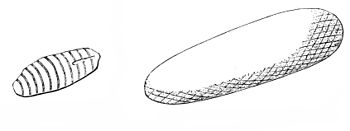deposition of her ova until a suitable medium is found for the requirements of the larva.
In two or three days the maggots were at work; their activity and voracity in devouring the putrescent mass of animal matter gave it the appearance of fermentation.
For observation in the live box, any little weakness connected with the somewhat objectionable odor arising from the garbage had to be got rid of and some few maggots washed clean. Neither immersion in water nor yet compression seemed to inconvenience them appreciably;

| Fig. 2.—Chrysalis of House- Fly, July 20, 1878, x 40. |
Fig. 3.—Egg of House-Fly, July 28, 1878, x 30. |
their leathery integument is not easily ruptured, and is sufficiently translucent to render the trachea, as well as the undulatory vermicular movement of the internal organs, apparent throughout under a low power; in fact, from its toughness, transparency, and strength, the larva is an excellent object for microscopic examination. When the animal matter was devoured, the maggots moved restlessly about, changing in color from yellowish-white to brownish-red; the cuticle became dense and opaque; motion gradually ceased, until the perfect insect emerged by forcing of the segments of the anterior end of the shell, occupying from fourteen to fifteen days in completing its series of life-changes.
Mr. Harkus's part of the experiment appears to be useful so far as to show the adaptability of the fly and its ova to circumstances, and that the larva assumes the chrysalid state when its supply of food becomes exhausted, although otherwise immature (in this case the animal matter given them would dry up), instead of dying from starvation.
The chrysalis and fly in his examples are undersized and impoverished, compared to those permitted to feed in a semi-fluid mass of animal matter.
In autumn the house-fly seems specially the victim to the attacks of a parasitic fungus (Empusa muscæ), and may be seen glued, as it were, to walls, a white powdery growth appearing at the segments of its body (the spores of the fungus). This vegetable pest is similar to, if not identical with, the parasite which causes so much destruction among fish in aquariums, and last year even attacked salmon in some English rivers.

